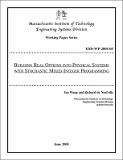| dc.contributor.author | Wang, Tao | |
| dc.contributor.author | de Neufville, Richard | |
| dc.date.accessioned | 2016-06-01T16:31:43Z | |
| dc.date.available | 2016-06-01T16:31:43Z | |
| dc.date.issued | 2005-06 | |
| dc.identifier.uri | http://hdl.handle.net/1721.1/102772 | |
| dc.description.abstract | The problem of building real options into physical systems has three features:
real options are not as easily defined as financial options;
path-dependency and interdependencies among projects mean that the standard tools of options analysis tools are insufficient; and
the focus is on identifying the best way to build flexibility into the design – not to value individual options.
This paper suggests a framework for exploring real options in physical systems that especially addresses these two difficulties. This framework has two stages: options identification and options analysis. The options identification stage consists of screening and simulation models that focus attention on a small subset of the possible combination of projects. The options analysis stage uses stochastic mixed-integer programming to manage the path-dependency and interdependency features. This stochastic formulation enables the analyst to include more technical details and develop explicit plans for the execution of projects according to the contingencies that arise. The paper illustrates the approach with a case study of a water resources planning problem, but the framework is generally applicable to a variety of large-scale physical systems. | en_US |
| dc.language.iso | en_US | en_US |
| dc.publisher | Massachusetts Institute of Technology. Engineering Systems Division | en_US |
| dc.relation.ispartofseries | ESD Working Papers;ESD-WP-2005-05 | |
| dc.title | Building Real Options into Physical Systems with Stochastic Mixed-Integer Programming | en_US |
| dc.type | Working Paper | en_US |
